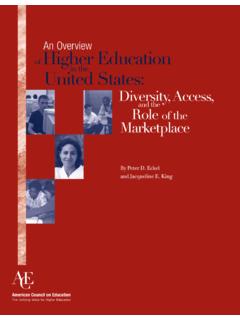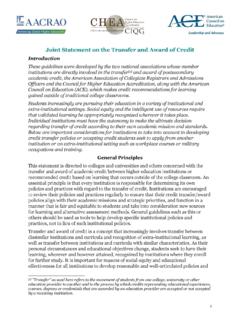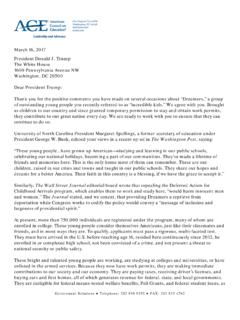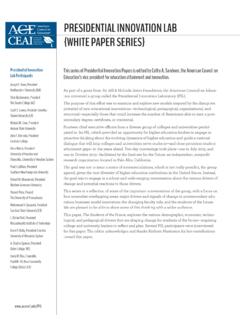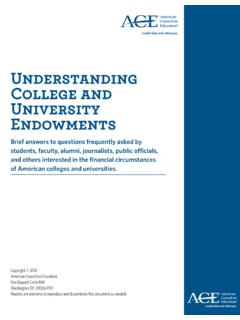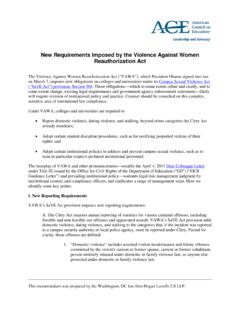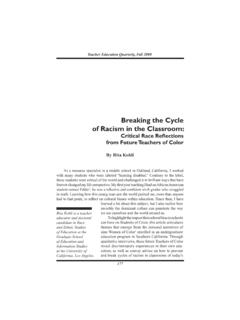Transcription of FUNDING EDUCATION AT HBCUs
1 Public and Private Investments and Divestments in Historically Black Colleges and Universitiesby Krystal L. Williams and BreAnna L. DavisAmericanCouncil on EducationISSUE BRIEFJ anuary 2019 ACKNOWLEDGMENTSWe gratefully acknowledge Joanna R. Frye from the National Forum on Higher EDUCATION for the Public Good for her contributions and guid-ance. Thank you to Brian K. Bridges, Brittini R. Brown, Brandon Daniels, Christopher J. Nellum, Cheryl Smith, and Jonathan M. Turk for their insight and partnership throughout the project. AUTHOR AFFILIATIONSK rystal L. Williams is an assistant professor of higher EDUCATION at the University of Alabama and a senior research fellow at the Frederick D. Patterson Research Institute at the United Negro College L. Davis is a senior evalu-ation associate at School Readiness Consulting and a former graduate student research fellow in the Freder-ick D. Patterson Research Institute at the United Negro College INSTITUTIONS SeriesEXECUTIVE SUMMARY1 FDPRI analysis of National Center for EDUCATION Statistics, Integrated Postsecondary EDUCATION Data System, 2014 Black Colleges and Universities ( HBCUs ) play a pivotal role in American society.
2 Federally designated as any college or university established prior to 1964 with the principal mis-sion of educating black Americans (White House Initiative on Historically Black Colleges and Uni-versities, ), these institutions represent about 3 percent of two-year and four-year public and private nonprofit institutions that participate in federal student financial aid programs, but award 17 percent of all bachelor s degrees earned by black Furthermore, HBCUs have awarded approximately a quarter (24 percent) of the bachelor s degrees earned by black students in science, technology, Public and Private Investments and Divestments in Historically Black Colleges and Universities 2engineering, and mathematics (STEM) since the early 2000s (Williams and Preston, forthcoming). This issue brief summarizes the federal, state, and local FUNDING sources of HBCUs and non- HBCUs in addition to private institutional investments to illustrate continuing disparities in how colleges and universities secure findings include: Public HBCUs rely on federal, state, and local FUNDING more heavily than their non-HBCU counterparts (54 percent of overall revenue versus 38 percent).
3 Confirming a commonly held belief, private HBCUs are slightly more tuition-dependent than their non-HBCU counterparts (45 percent tuition-dependent compared with 37 percent tuition-dependent). Private gifts, grants, and contracts make up a smaller percentage of overall revenue for private HBCUs relative to their non-HBCU counterparts (17 percent versus 25 percent). Both public and private HBCUs experienced the steepest declines in federal FUNDING per FTE student between 2003 and 2015, with private HBCUs seeing a 42 percent reduction the most substantial of all sectors. Within both public and private sectors, HBCU endowments lag behind those of non- HBCUs by at least 70 percent; this gap jeopardizes an HBCU s ability to buffer decreases in state and federal key findings reveal one overarching differ-ence in FUNDING between HBCUs and non- HBCUs : despite efforts to counter a historical legacy of inequitable FUNDING and notable investments by the federal government and many state govern-ments, resource inequities continue to plague HBCUs .
4 FUNDING EDUCATION AT HBCUsRising college costs, student debt, and federal budget cuts have positioned higher EDUCATION finance as a pressing issue within policy circles and among the broader public (Jaschik 2017; Roth-man 2016; Saunders, Williams, and Smith 2016). Given concerns about college finance, it is import-ant to understand the broader context of revenue streams for both public and private institutions. This is especially important for institutions such as HBCUs , where over 70 percent of students have limited financial resources to pay for college and rely heavily on other forms of aid (Saunders, Williams, and Smith 2016). Given the financial constraints of many HBCU students, it is important to better understand the various sources of revenue that these institutions pull from besides tuition and for American colleges and universities is derived primarily from 1) public sources ( , federal, state, and local appropriations, grants and contracts), 2) private investments ( , gifts, grants, and contracts), 3) tuition and fees, and 4) other income ( , auxiliary income).
5 While both HBCUs and non- HBCUs rely on each of these FUNDING streams, they do so to varying degrees. This brief examines these revenue sources to illuminate how HBCUs are funded compared with non- HBCUs . The data also demonstrate how these sources have been historically inequitable and continue that trend in the present day. All estimates focus spe-cifically on four-year public and private nonprofit and Private Investments and Divestments in Historically Black Colleges and Universities 3 TOTAL REVENUE SOURCES2 All HBCU estimates exclude Howard University (DC) because of the unique FUNDING arrangement resulting from its status as a congressionally chartered The difference in revenue shares for public HBCUs and non- HBCUs from public sources reflects the fact that HBCUs have a lower amount of overall revenue; the federal, state, and local FUNDING that they receive represents a larger share of their smaller 1 provides insights about how institu-tional revenue for public and private HBCUs and non- HBCUs is driven by different These estimates illustrate proportional revenue contribu-tions from the sources noted previously.
6 Figure 1. Average Revenue Shares at Public and Private Nonprofit Four-Year HBCUs and Non- HBCUs , 2015 Private Gifts, Grants, and Contracts*Federal, State, and Local Appropriations, Grants, and ContractsNet Tuition RevenueAuxiliary and Other IncomeSource: National Center for EDUCATION Statistics, Integrated Postsecondary EDUCATION Data System*Includes investment income such as interests on : Totals may not add up to 100 due to 4-Year HBCUsPublic 4-Year Non-HBCUsPrivate NFP 4-Year HBCUsPrivate NFP 4-Year Non-HBCUs25%37%9%29%17%45%12%26%4%27%38% 31%1%27%54%19%The data demonstrate that public institutions receive a greater proportion of their overall FUNDING from federal, state, and local resources than private institutions. However, reliance on these sources differs between public HBCUs and public non- HBCUs . Among public institutions, HBCUs are more dependent on FUNDING from federal, state, and local governments than non- HBCUs (54 percent of their revenue compared with 38 percent).
7 These estimates do not suggest that the total amount of federal, state, and local FUNDING that public HBCUs receive is greater than public non- HBCUs . In 2015, public four-year HBCUs received about $ billion in federal, state, and local funds, while non- HBCUs received a little over $94 billion from the same sources. However, when overall revenue is exam-ined, these sources simply provide a larger share of total revenues at public HBCUs relative to their public non-HBCU Although private institutions are generally less dependent on public sources, it should also be noted that private HBCUs receive a larger share of their FUNDING from these sources FINDING 1 Public HBCUs rely on federal, state, and local FUNDING more heavily than non- HBCUs (54 percent of overall revenue ver-sus 38 percent).FINDING 2 Private HBCUs are slightly more tuition-dependent than their non-HBCU counterparts (45 percent more tuition-dependent compared with 37 percent).
8 Public and Private Investments and Divestments in Historically Black Colleges and Universities 4than private non- HBCUs (12 percent of their revenue compared with 9 percent).While public funds are the largest source of rev-enue for public institutions, private institutions are generally more tuition dependent ( , private institutions depend more heavily on tuition and fees for their FUNDING than public institutions). This also holds true for both HBCUs , with private HBCUs receiving a larger percentage of their over-all revenue from tuition and fees (45 percent versus 37 percent). In addition, without the same degree of public financial support, private colleges and universities rely heavily on FUNDING from private gifts, grants, and contracts, as well as auxiliary and other sources of income ( , residence halls, food services, book stores, parking, intercollegiate athletics).
9 Although private investments are critical sources of FUNDING for many private institutions, the proportion of universities overall budget from these sources is higher for private non- HBCUs than private HBCUs (25 percent com-pared with 17 percent; see Figure 1). Furthermore, private non- HBCUs receive a slightly higher proportion of their overall revenue from auxiliary and other sources compared with private HBCUs (29 percent versus 26 percent). It is also worth noting that auxiliary and other income compose a considerably higher percentage of revenue for public non- HBCUs than their HBCU counterparts (31 percent versus 19 percent).Figure 1 reveals just how unique HBCU FUNDING profiles are in three key areas: public sector support ( , federal, state, and local appropriations; grants and contracts), private investments ( , gifts, grants, and contracts), and tuition revenue. Within both the public and private sectors, FUNDING from public sources makes up a larger share of the fund-ing profiles of HBCUs compared with non-HBCU institutions.
10 This underscores the importance of a healthy partnership between HBCU leadership and federal, state, and local governments for continued institutional vitality. Compared with their private non-HBCU peers, private HBCUs benefit less from private investments. Ultimately, the limited private funds for private HBCUs further explain their dependence on tuition revenue. Moreover, their reliance on governmental funds further emphasizes the importance of public support. The following sections provide more detailed insights about HBCU FUNDING from public and private sources, relative to non- HBCUs . FEDERAL FUNDING FOR HBCUs AND NON-HBCUsThe Department of EDUCATION (ED) provides the bulk of federal funds to colleges and univer-sities indirectly through the federal student aid programs via Title IV of the Higher EDUCATION Act (HEA). HBCUs also receive direct subsidies from ED through Title III, Part B of the HEA, which provides financial assistance to Historically Black Colleges and Universities ( HBCUs ) to establish or strengthen their physical plants, financial manage-ment, academic resources, and endowment-build-ing capacity ( Department of EDUCATION 2017).
